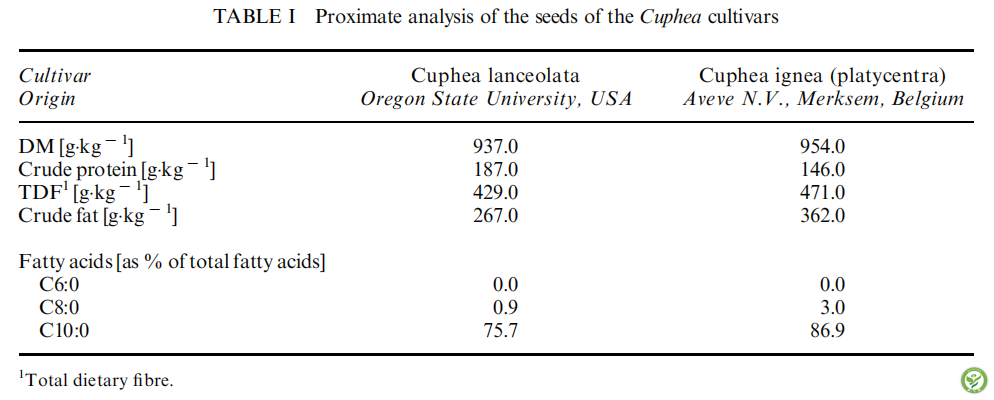第27期:断奶仔猪日粮使用富含中链脂肪酸的萼距花属植物种子和外源脂肪酶的研究
【摘要】为寻找仔猪饲料中饲用抗生素的替代品,本文研究了添加含有天然来源的具有抗菌功能的中链脂肪酸(MCFA)的萼距花属植物种子和外源脂肪酶在断奶仔猪日粮中的作用。同时对断奶仔猪的前肠菌群、肠道形态、部分消化参数以及生产性能做了研究。将30头初始体重为7.0±0.4kg的断奶仔猪,按照窝别、性别和体重分为两组(对照日粮; Cuphea +脂肪酶日粮)。将Cuphea种子(lanceolata和ignea)(50g /kg)替代对照日粮中的大豆油(15g / kg),Alphacell(25g / kg)和大豆分离蛋白(10g / kg)。在Cuphea日粮中加入500mg / kg的微生物脂肪酶。仔猪在第0,3,7,14和16天分别称重。同时在第0-3,3-7,7-14和14-16天期间记录每栏仔猪的采食量。第7天,将每个组的五只小猪安乐死,用于计数胃和小肠的肠道菌群以及小肠的两个位点(近端,远端)的肠道形态。实验结果表明:喂食Cuphea+脂肪酶日粮的仔猪的生产性能参数有着升高的趋势。经过相关酶解得到的MCFA(1.7g / kg新鲜胃内容物)有着降低近端小肠中大肠菌群数量的趋势,但其增加了胃和远端小肠的数量。在Cuphea组中,链球菌的数量在仔猪小肠中降低显著,但在胃中不显著,而乳酸杆菌的数量在远端小肠中降低显著且在胃和近端小肠中均趋于降低。在这些日粮组中,胃或肠道中的总厌氧微生物并没有显著差异。Cuphea +脂肪酶组仔猪的绒毛高度增加显著(远端小肠)和较低的隐窝深度(近端和远端小肠)和绒毛长度与隐窝深度的比值增大(近端和远端小肠)。饲喂Cuphea +脂肪酶日粮的仔猪,每100个肠上皮细胞内的淋巴细胞(IEL)的数量在近端小肠中降低显著而在远端小肠中则趋于降低。这两种现象均表明仔猪的肠道粘膜有着更好和更健康的功能状态。此结果与之前研究结果一致,表明胃和前肠中的相关酶催化得到的MCFA作用于肠道生态系统可以提高仔猪的生产性能,这使得MCFA能够成为饲用抗生素的替代物。
【关键词】Cuphea;种子;断奶;仔猪;中链脂肪酸;抗菌性能;肠道微生物;肠;形态学
以下是实验中的相关图表
表1:Cuphea品种种子的近似分析

表2:日粮的组成成分和化学成分(以饲喂为基础)

表3:在室温储存期间,内源性和外加脂肪酶对磨碎的Cuphea种子释放游离脂肪酸的影响(平均值)

表4:日粮对仔猪的生产性能的影响(平均值)

表5:日粮的脂肪酸组成,屠宰后仔猪的胃和上部小肠内容物的总脂肪酸(TFA)和游离脂肪酸(FFA)组成(平均值±误差,n = 5)

表6:日粮对胃和小肠的微生态系统的影响[CFU log10/g 新鲜日粮](平均值±误差,n=5)

表7:胃和小肠内容物的pH和干物质含量[g kg-1新鲜内容物](平均值±误差,n = 5)

表8:日粮组成对一些营养素的胃、回肠、粪便的表观消化率(DC)的影响(平均值±误差,n=5)

表9:日粮对近端和远端小肠的绒毛高度和隐窝深度的影响(平均值±误差,n = 5;每个猪和每个位点测量10个值)

表10:日粮对近端和远端小肠绒毛上皮内淋巴细胞(IELs)数量的影响(5只仔猪的平均值±误差;每个猪和每个位点测量10个值)

启示
当前结果与之前研究结果一致:表明经过胃和前肠中的相关酶催化得到的MCFA作用于肠道微生态系统可以提高仔猪的生产性能,尽管某些参数不太明显,但这使得MCFA能够成为饲用抗生素的潜在替代物。
Abstract
In search for an alternative for nutritional antimicrobials in piglet feeding, the effects of adding whole Cuphea seeds, as a natural source of medium chain fatty acids (MCFA), with known antimicrobial effects, and an exogenous lipase to a weaner diet were studied. The foregut flora, the gut morphology, some digestive parameters and the zootechnical performance of weaned piglets were investigated. Thirty newly weaned piglets, initial weight 7.0+0.4 kg, were divided according to litter, sex and weight in two groups (control diet; Cuphea+lipase diet). The Cuphea seeds (lanceolata and ignea) (50 g kg-1) were substituted for soybean oil(15 g kg-1), Alphacell (25 g kg-1) and soy protein isolate (10 g kg-1) in the control diet. Also 500 mg kg-1microbial lipase was added to the Cuphea diet. The piglets were weighted individually on days 0, 3, 7, 14 and16. Feed intake was recorded per pen during days 0 to 3, 3 to 7, 7 to 14 and 14 to 16. On day 7 five piglets of each experimental group were euthanized for counting the gastric and small intestinal gut flora and for gut morphology at two sites of the small intestine (proximal, distal). The results indicate a trend towards improved performances parameters by feeding Cuphea+lipase. The enzymic released MCFA (1.7g kg-1 fresh gastric contents) tended to decrease the number of Coliforms in the proximal small intestine, but increased the number in the stomach and distal small intestine. With Cuphea, the number of Streptococci was significantly lower in small intestine, but not in the stomach, while the number of Lactobacilli was significantly lower in the distal small intestine and tended to be lower in the stomach and proximal small intestine. No differences between the diets were noted for the total anaerobic microbial load in the stomach or in the gut. Feeding Cuphea+lipase resulted in a significantly greater villus height (distal small intestine) and a lesser crypt depth (proximal and distal small intestine) and greater villus/crypt ratio depth (proximal and distal small intestine). The intra-epithelial lymphocyte (IEL) counts per 100 enterocytes were significantly decreased in the proximal small intestine and tended to decrease in the distal small intestine by feeding the Cuphea+lipase diet. Both phenomena are indicative for a more healthy and better functional state of the mucosa. Present results are in line with foregoing research, showing that manipulation of the gut ecosystem by the enzymic in situ released MCFA in the stomach and foregut can result in improved performances of the piglets, which makes the concept a potential alternative for in-feed nutritional antibiotics.
Keywords: Cuphea; Seeds; Weaning; Piglets; Medium chain fatty acids; Antimicrobial properties; Intestinal microorganisms; Intestine; Morphology
Conclusion
The present results, although less pronounced for some parameters, are in line with foregoing research, showing that manipulation of the gut ecosystem by the enzymic in situ released MCFA in the stomach and fore-gut may result in improved performances of the piglets,which makes the concept a potential alternative for in feed nutritional antibiotics.
如您需原文,请联系本文作者和出版方,或请垂询肠动力研究院。本网站发布的所有资料将尽最大可能注明出处、作者及日期,如无意中侵犯了您的知识产权,请来信及时告知,我们将立即予以删除。
All information released by the WeChat Official Account will do its best to indicate the source, author and date. If we inadvertently infringe on your intellectual property, please inform us in time and we will delete it immediately.









